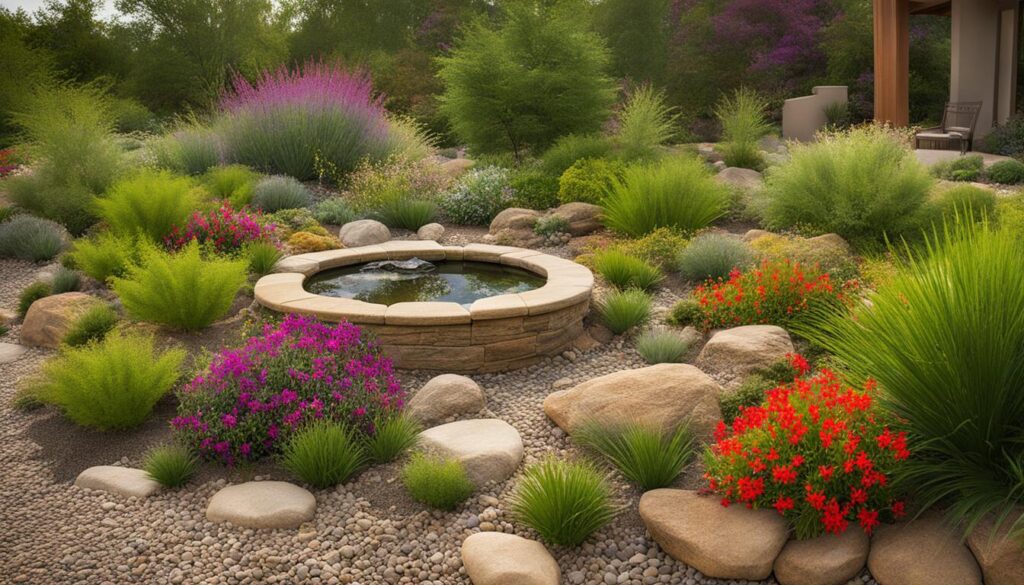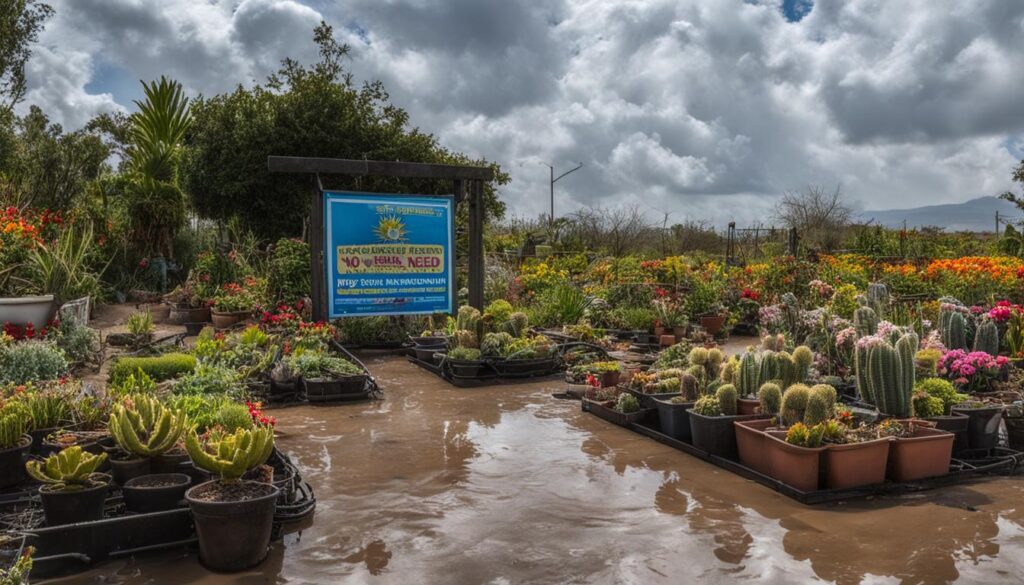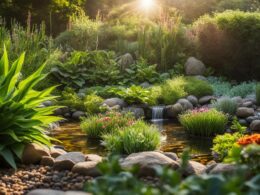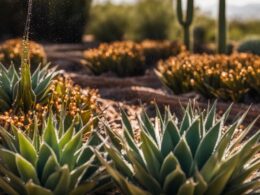Xeriscaping is a sustainable landscaping strategy that focuses on water conservation and the use of drought-tolerant native plants. It has gained popularity, especially in water-scarce regions like the western United States. By replacing traditional lawns with soil, rocks, mulch, and native plant species, xeriscaping not only conserves water but also promotes environmental sustainability and financial benefits. Efficient irrigation methods, such as drips and soaker hoses, play a vital role in this eco-friendly practice. With the right plants and sustainable practices, you can create a beautiful, low-maintenance landscape while preserving local habitats and ecosystems.
Key Takeaways:
- Eco-friendly xeriscaping focuses on water conservation and the use of drought-tolerant native plants.
- Replacing traditional lawns with native plants saves water and promotes environmental sustainability.
- Efficient irrigation methods, such as drips and soaker hoses, are crucial in xeriscaping.
- Xeriscaping can create a beautiful, low-maintenance landscape while preserving local habitats.
- By choosing the right plants and implementing sustainable practices, you can contribute to a greener, more sustainable world.
The Environmental Benefits of Xeriscaping
Xeriscaping offers numerous environmental benefits. By opting for drought-tolerant native plants, xeriscaping reduces the need for excessive watering, contributing to water conservation efforts. Xeriscaped landscapes require minimal irrigation beyond what the natural climate provides, reducing the strain on limited water resources, particularly in areas prone to drought. Moreover, xeriscaping promotes the use of vegetation that is appropriate for the climate, resulting in healthier and more resilient landscapes. Native plants and xerophytes, which are plants adapted to arid climates, play a crucial role in conserving water while enhancing local ecosystems. By replacing traditional lawns with xeriscaped gardens, individuals can support biodiversity and create habitats for wildlife.
The Benefits of Xeriscaping:
- Reduces the need for excessive watering
- Conserves water and supports water conservation efforts
- Promotes healthier and more resilient landscapes
- Enhances local ecosystems and supports biodiversity
“Xeriscaping reduces the strain on limited water resources and creates habitats for wildlife.”
To illustrate the environmental benefits of xeriscaping, consider the following table comparing the water usage of traditional lawns versus xeriscaped gardens in different regions:
| Region | Traditional Lawn (gallons of water per day) | Xeriscaped Garden (gallons of water per day) | Water Savings |
|---|---|---|---|
| Denver, Colorado | 1,500 | 500 | 1,000 |
| Phoenix, Arizona | 2,000 | 800 | 1,200 |
| Los Angeles, California | 1,800 | 700 | 1,100 |
As shown in the table, xeriscaping can result in significant water savings, making it an environmentally responsible choice for landscaping.
By adopting xeriscaping techniques and choosing drought-tolerant vegetation, you can reduce water consumption, support local ecosystems, and create a visually appealing landscape that thrives in harmony with the environment.
The Financial Benefits of Xeriscaping
Xeriscaping not only offers environmental advantages but also provides significant financial benefits. By implementing water-conserving landscaping practices, homeowners can experience substantial savings on their water bills. With xeriscaping, you can reduce water usage by up to 75 percent compared to traditional lawns, which translates to significant cost savings over time.
In areas facing water scarcity and drought, such as the western United States, xeriscaping can lead to even greater financial benefits. Many regions offer incentives, such as rebates or reduced water rates, to encourage homeowners to adopt xeriscaping practices. These incentives can further offset the initial investment in transforming your landscape.
Table: Water Bill Savings with Xeriscaping
| Region | Estimated Water Savings (per month) | Potential Yearly Savings |
|---|---|---|
| Novato, California | Approximately 120 gallons per day* | Up to 43,800 gallons |
| Denver, Colorado | 30 to 60 percent reduction in water usage | Varies based on individual consumption |
| Austin, Texas | Up to 60 percent reduction in water usage | Varies based on individual consumption |
In addition to water bill savings, xeriscaping requires less maintenance compared to traditional lawns. With reduced water needs and the use of native, drought-tolerant plants, you’ll spend less time and money on mowing, fertilizing, and pest control. Xeriscaped landscapes are designed to thrive in their natural environment, resulting in lower maintenance costs and fewer inputs required.
By embracing xeriscaping, you can create a beautiful, sustainable landscape while also enjoying the financial benefits of reduced water consumption and maintenance expenses. Take advantage of the incentives offered in your region and start saving money while conserving water with xeriscaping.
*Estimated water savings based on a household with traditional lawns converting to xeriscaping practices.
Native Plants for Xeriscaping
Xeriscaping relies on selecting native plants that are well-suited for the local climate and require minimal water. By choosing the right plants, you can create a visually appealing and sustainable xeriscape while minimizing water usage and maintenance requirements.
For xeriscaping, consider incorporating drought-resistant plants such as cacti, agave, juniper, lavender, and various herbs and spices. These plants have evolved to adapt to arid environments and have developed mechanisms to conserve water, making them ideal choices for water-efficient landscapes.
Using a variety of native plants in your xeriscape can also enhance its aesthetic appeal. Mix different textures, colors, and heights to create visual interest and provide habitat for local wildlife. Here is a table showcasing some popular native plants for xeriscaping:
| Plant | Water Requirements | Growth Habit |
|---|---|---|
| Cacti (Opuntia spp.) | Low | Succulent |
| Agave (Agave spp.) | Low | Rosette-forming |
| Juniper (Juniperus spp.) | Low to moderate | Evergreen shrub or tree |
| Lavender (Lavandula spp.) | Low | Herbaceous perennial |
| Herbs and spices (Thymus, Salvia, Rosemary, etc.) | Low to moderate | Herbaceous |
Remember, these are just a few examples, and there are many more native plants to choose from based on your specific region. Consult with local nurseries or gardening experts to identify the best native plants for your xeriscape.
Creating a Balanced Xeriscape
Incorporating a mix of native plants can help create a balanced and visually appealing xeriscape. Consider the following when selecting plants:
- Choose a variety of plants with different water requirements, including some that are highly drought-tolerant and others that can handle moderate water levels.
- Select plants that offer a range of heights, textures, and colors to create visual interest and structure in your xeriscape.
- Include both flowering and non-flowering plants to provide food and habitat for pollinators and other wildlife.
- Consider using native grasses and groundcovers to fill in gaps and add a natural, aesthetic touch to your xeriscape.
By carefully selecting and arranging your native plants, you can create a xeriscape that is not only water-efficient but also visually appealing and supportive of local ecosystems.
Xeriscaping Success Stories
Discover the inspiring xeriscaping success stories that showcase the transformative power of eco-friendly landscapes and sustainable gardening practices. These real-life examples demonstrate how individuals have embraced xeriscaping to create visually stunning outdoor spaces while contributing to water conservation efforts and supporting local ecosystems.
Denver, Colorado: Leading the Way
In Denver, Colorado, xeriscaping has become a pioneering movement in urban areas. The city’s water department actively promotes xeriscaping as a way to reduce the use of drinkable water for lawns and gardens, leading to significant water savings. Residents have embraced this approach and transformed their landscapes into beautiful and sustainable havens that thrive with native plants and drought-tolerant vegetation.
Novato, California: Saving Water, One Garden at a Time
In Novato, California, homeowners who participated in xeriscaping programs reported impressive reductions in water usage. By converting traditional lawns into water-efficient xeriscapes, residents saved an estimated 120 gallons of water per day. These success stories highlight the impact that individual actions can have on water conservation and showcase the financial benefits that come with adopting xeriscaping practices.
By sharing these xeriscaping success stories, we hope more individuals will be inspired to embrace sustainable gardening and create eco-friendly landscapes in their own communities. Together, we can make a difference in conserving water, preserving the environment, and enjoying the beauty of our outdoor spaces in a responsible and sustainable way.
| City | Water Savings |
|---|---|
| Denver, Colorado | Significant reduction in water use |
| Novato, California | Estimated 120 gallons of water saved per day |
Xeriscaping Myths and Misconceptions
Despite its numerous benefits, xeriscaping is sometimes subject to myths and misconceptions. One common misconception is that xeriscapes are dry, barren, and lacking in beauty. In reality, xeriscapes can be lush, diverse, and visually appealing when designed with the right selection of native plants and landscape elements.
“Xeriscaping can be a beautiful and sustainable way to create an outdoor space that is both visually appealing and environmentally friendly,” says landscape designer Jane Smith. “By using native plants, you can create a vibrant and diverse landscape that attracts pollinators and wildlife.”
Another misconception is that xeriscaping requires eliminating all grass and lawns. While xeriscaping involves reducing the use of water-intensive grass, it doesn’t mean eliminating grass altogether. Incorporating regionally appropriate grasses that are drought-tolerant can still be a part of a water-efficient landscape.
Challenging these misconceptions is essential to encourage more individuals to adopt xeriscaping practices and reap the benefits. With proper planning and design, xeriscaping can transform outdoor spaces into sustainable, water-efficient landscapes that are both visually appealing and environmentally responsible.
Debunking Common Xeriscaping Myths
To further dispel misconceptions about xeriscaping, let’s examine some of the most common myths:
- Myth: Xeriscapes are boring and lack color. Reality: Xeriscapes can be visually stunning with a wide range of colorful and flowering native plants.
- Myth: Xeriscaping requires expensive and extensive renovations. Reality: Xeriscaping can be done gradually, starting with small changes and additions to your existing landscape.
- Myth: Xeriscaping is only for arid desert regions. Reality: Xeriscaping can be adapted to any climate, as native plants can be found for a variety of environmental conditions.
- Myth: Xeriscaping is high-maintenance. Reality: Once established, xeriscapes require less maintenance than traditional lawns, saving time and effort.
The Benefits of Overcoming Xeriscaping Misconceptions
By dispelling myths about xeriscaping, we can encourage more people to embrace this water-efficient landscaping technique. The benefits of xeriscaping are numerous:
- Water conservation: Xeriscaping reduces the need for excessive watering, helping to conserve precious water resources.
- Cost savings: By using less water and requiring lower maintenance, xeriscaped landscapes can result in significant cost savings over time.
- Environmental sustainability: Xeriscaping promotes biodiversity, supports local ecosystems, and reduces chemical and water runoff.
- Resilience to drought: Xeriscaped gardens are better equipped to withstand periods of drought and water restrictions.
| Myth | Reality |
|---|---|
| Xeriscapes are boring and lack color. | Xeriscapes can be visually stunning with a wide range of colorful and flowering native plants. |
| Xeriscaping requires expensive and extensive renovations. | Xeriscaping can be done gradually, starting with small changes and additions to your existing landscape. |
| Xeriscaping is only for arid desert regions. | Xeriscaping can be adapted to any climate, as native plants can be found for a variety of environmental conditions. |
| Xeriscaping is high-maintenance. | Once established, xeriscapes require less maintenance than traditional lawns, saving time and effort. |
Getting Started with Xeriscaping
If you’re looking to create a sustainable and water-efficient landscape, xeriscaping is the way to go. By implementing eco-friendly practices and choosing the right plants, you can transform your outdoor space into a beautiful and low-maintenance oasis. Here are some tips to help you get started with xeriscaping:
Assess Your Local Climate and Soil Conditions
Before diving into xeriscaping, it’s important to understand your local climate and soil conditions. Different regions have varying levels of rainfall and soil types, which will impact the types of plants that thrive in your area. Research native plant species and drought-tolerant varieties that are well-suited to your climate. This will ensure that your xeriscape is not only visually appealing but also able to withstand the local weather conditions.
Group Plants Based on Water Needs
A key principle of xeriscaping is optimizing water use. To achieve this, group plants with similar water requirements together. This allows you to efficiently allocate water resources and avoid overwatering or underwatering certain areas. By creating distinct zones within your landscape based on water needs, you can tailor your irrigation system accordingly, minimizing water waste and maximizing plant health.
Implement Efficient Irrigation Methods
Efficient irrigation is a critical component of xeriscaping. Consider using drip irrigation systems or soaker hoses that deliver water directly to the plant’s root zone. This minimizes evaporation and ensures that water is used efficiently. Monitor your watering schedule and adjust it based on plant needs and weather conditions. By being mindful of water usage, you can reduce waste and conserve this precious resource.
| Plant | Water Requirements | Benefits |
|---|---|---|
| Lavender | Low | – Drought-tolerant – Attracts pollinators |
| Agave | Low | – Succulent plant – Thrives in arid climates |
| Yucca | Low | – Drought-tolerant – Adds architectural interest |
| Rosemary | Low | – Fragrant herb – Requires little water |
Remember to prepare your soil by adding organic matter and mulch to improve water retention and enhance soil health. This will help your plants thrive and reduce the need for excessive watering.
With these tips, you can start your xeriscaping journey and create a sustainable, water-efficient landscape that not only conserves water but also enhances the beauty of your outdoor space.
Conclusion
In conclusion, eco-friendly xeriscaping is a sustainable and responsible approach to landscaping that offers numerous benefits. By embracing xeriscaping practices and using drought-tolerant native plants, you can create beautiful and sustainable outdoor spaces while conserving water and supporting local ecosystems. With xeriscaping, you can reduce water usage by up to 75%, resulting in significant savings on water bills. Additionally, xeriscaping requires less maintenance compared to traditional lawns, saving you time and money.
By implementing efficient irrigation methods such as drip systems and soaker hoses, you can ensure that water is directed to the base of plants, minimizing evaporation and optimizing water use. Xeriscaping also promotes biodiversity by creating habitats for wildlife and preserving local ecosystems. By selecting regionally appropriate plants and incorporating elements of xeriscaping into your landscape, you can contribute to a greener and more sustainable world.
In summary, eco-friendly xeriscaping with native plants is a win-win solution. You can create visually appealing outdoor spaces, save water and money, and support the environment. So why wait? Start your xeriscaping journey today and enjoy the beauty and sustainability of your outdoor space for years to come.













